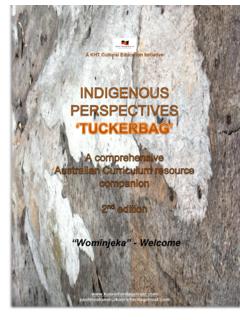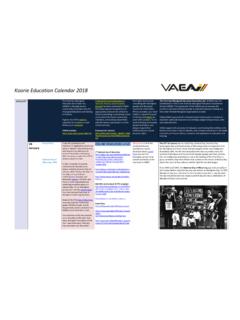Transcription of Koorie Education Calendar 2021 - VAEAI
1 Koorie Education Calendar 2021 . JANUARY The Victorian Aboriginal Education Association Inc. ( VAEAI ) is the peak Koorie community-controlled body for Aboriginal Education and training in Victoria. Explore the VAEAI website , subscribe for newsletters and follow us on Facebook. VAEAI website: Protocols for Koorie Education in Victorian Primary and Secondary Schools has been produced by VAEAI following requests for guidance on appropriate protocols for schools to follow in providing a welcoming school environment for Koorie community members, and working respectfully with the Koorie community to enrich school curricula. Protocols for schools: CLICK HERE We highly recommend consulting with Aboriginal people and Aboriginal sources for information. Where available, your local LAECG is a good first point of contact and VAEAI can assist with contacts. Try to work with local community people and Elders, and always respect their intellectual and cultural property rights.
2 The Victorian Aboriginal Education Association Inc. ( VAEAI ) was first established in 1976 as the Victorian Aboriginal Education Consultative Group (VAECG). The shared aim of the VAECG was to increase the presence and voice of Koorie people in Education decision making at a time when limited Aboriginal organisations existed. Today VAEAI continues to represent the Victorian Koorie Community in relation to Education policy development and strategic programming at local, state and national levels. VAEAI supports the provision of Education and training that reinforces the Koorie community s cultural identity, and increases awareness in the wider community of Koorie cultures, histories and aspirations in Education and training. 26 January Survival Day National Day of Mourning, 1938 Aboriginal Tent Embassy, est. 1972 A day off, a barbecue and fireworks? A celebration of who we are as a nation?
3 A day of mourning and invasion? A celebration of survival? Australians hold many different views on what the 26th of January means to them. In 2017 some councils controversially decided to no longer celebrate Australia Day on this day, and Change the Date is the slogan of a prominent campaign and subject of many debates. This however is not the first protest held on January 26. Research the First Day of Mourning, involving Victorian Yorta Yorta leaders William Cooper and Sir Doug Nicholls. In 1972 on this day, the Aboriginal Tent Embassy was set on the lawns of Canberra House, a huge thing at the time! Consider why there is continuing debate and conflicting emotions about our national day. For an Aboriginal perspective read the communiqu from the National Peak body of Aboriginal health organisations. ONLINE RESOURCES in full 1st National Day of Mourning: NACCHO communiqu & Change the Date campaign Lionel Rose Did you know that the celebrated Kurnai-Gunditjmara world champion boxer Lionel Rose was the first Aboriginal person to be named Australian of the Year back in 1968?
4 The Australian of the Year Awards occur annually on this date. How many Aboriginal Australians of the Year have there been? Who are they and where are they from? A weary eyed Lionel Rose clutches his world title trophy after beating Alan Rudkin in Melbourne 1969 CREDIT: SMH, STAFF PHOTOGRAPHER More about Lionel Rose The 26th of January aka Australia Day, Survival Day, Invasion Day, Sovereignty Day and National Day of Mourning marks an important time for Aboriginal and Torres Strait Islander people and for non-Indigenous Australians alike. For the first Australians the day essentially marks the survival of Aboriginal and Torres Strait Islander people and their cultures. For non-Indigenous Australians it marks the landing of the First Fleet, a group of eleven ships from Britain that landed on the shores of Botany Bay where the clash of two cultures and the fight for one land began.
5 The first Day of Mourning was a protest held by Aboriginal Australians on 26 January 1938, the 150th anniversary of the British colonisation of Australia. From 1940 until 1955, the National Day of Mourning was held annually on the Sunday before Australia Day and was known as Aborigines Day. In 1955 Aborigines Day was shifted to the first Sunday in July after it was decided the day should become not simply a protest day but also a celebration of Aboriginal culture and survival. Koorie Education Calendar 2021 . FEBRUARY 4 February The Cummeragunja Walk-off Anniversary Read about the historic protest known as the Cummeragunja Walk-off protest on the Deadly Story website. With older students watch The Legacy of a People (on DVD) about the Shepparton Koorie community and Cummeragunja Reserve, and investigate the reasons for the Cummeragunja Walk-off of 1939 ( VAEAI has a limited number of copies).
6 The archived Mission Voices website developed by the Koorie Heritage Trust is a great resource. Listen to the late Bangerang Elder Uncle Sandy Atkinson and others from Cummeragunja discuss life in the day and connection to place. (Real Player download may be needed). With younger students (years 5-8) explore the links where Uncle Sandy talks about conservation practices. What evidence is there that people lived in harmony with their land? Provide at least one specific example of their conservation practices. Based on the Cummeragunja Walk-off of 39, research the opera Pecan Summer by Yorta Yorta composer Deborah Cheetham, AO the first opera written by an Indigenous Australian involving an Indigenous caste. A filmed performance of Pecan Summer is now available on SBS On Demand and a number of video clips and news reports on YouTube. Research Deborah Cheetham and her journey to be an opera singer and author.
7 Deadly Story: Legacy of a People Cummeragunja and Mission Voices Pecan Summer +summer+youtube&dcr=0&source=lnms&tbm=vi d&sa=X&ved=0ahUKEwjD8pL14urYAhUDU7wKHaQ7 DG4Q_AUICigB&biw=1222&bih=721- Image from The Bunyip of Berkeley's Creek Written by Jenny Wagner and illustrated by Ron Brooks First edition: Longman Young Books, Melbourne, 1973. Did you know that the legendary Bunyip is said to get its name from the Wemba Wemba and Wergaia languages of the Murray River Region? Significantly in 2016, rock art featuring four bunyips was rediscovered in a sandstone shelter in Victoria s Gariwerd region aka the Grampians. The Age newspaper reported that this find shines new light on an age-old story that of a cosmic struggle between creator spirit and his monstrous enemy. (2019) Numerous tales of the bunyip in written literature appeared in the 19th and early 20th centuries.
8 One of the earliest known is a story in Andrew Lang's The Brown Fairy Book (1904). Cummeragunja lies on the NSW side of Dhungala the Murray River on the traditional lands of the Bangerang and Yorta Yorta peoples. The river is hugely important to the people and has sustained them for thousands of years. On the 4th February 1939, over 200 residents of the Cummeragunja Mission walked off the mission station in protest against conditions at the station, and crossed the Murray River into Victoria, leaving the state of New South Wales. At the time, this was in contravention of rules set by the New South Wales Aboriginal Protection Board restricting the movement of Aboriginal people. Many settled in Barmah, Echuca, Shepparton, Mooroopna and Melbourne s Fitzroy. The Cummeragunja Walk Off has been described as the first ever mass strike of Aboriginal people in Australia and brought about changes to the Aborigines Protection Act of NSW.
9 Pecan Summer is Australia s first Indigenous opera, written by Yorta Yorta soprano, Deborah Cheetham AO. The opera is based on the events surrounding the walk-off from Cummeragunja mission in 1939. Pecan Summer brings together the largest ensemble of Indigenous performers of any professional production in Australia. Book online at for the 10th anniversary gala performances of Pecan Summer at the magnificent Melbourne Recital Centre on October 30 & 31, 2020. Koorie Education Calendar 2021 . Murray River focus Focus learning activities around Koorie peoples, languages and stories of the Murray River region, like the Bangerang Dreaming story about the creation of Dungala aka the Murray River, and the famous Bunyip stories. Watch this creation story in Bangerang language in this Sharing Stories animation made by St. Georges Primary School, Shepparton.
10 Depending on the region and language group, there are a variety of Creation Stories about the Murray River. See: Ponde the Murray Cod River Creator. BTN-produced River Kids looks at life along Australia's largest river system - the Murray River, narrated by Tyrone, a young SA Ngarrindjeri boy who introduces us to the people who depend on it. Watch with students. Murray River Country: An ecological dialogue with traditional owners by geographer Jessica Weir with teaching notes discusses the water crisis from a unique perspective - the intimate stories of love and loss from the viewpoints of Aboriginal peoples who know the inland rivers as their traditional country. Available in e-book format. The AIATSIS Living off our Waters collection tells the history and value of fishing for Aboriginal and Torres Strait Islander people with three community case studies. Australian Curriculum - aligned Indigenous Knowledge: Living Waters, suggests learning activities targeted to year 4, which could be adapted for other levels, linked to the AIATSIS site.



